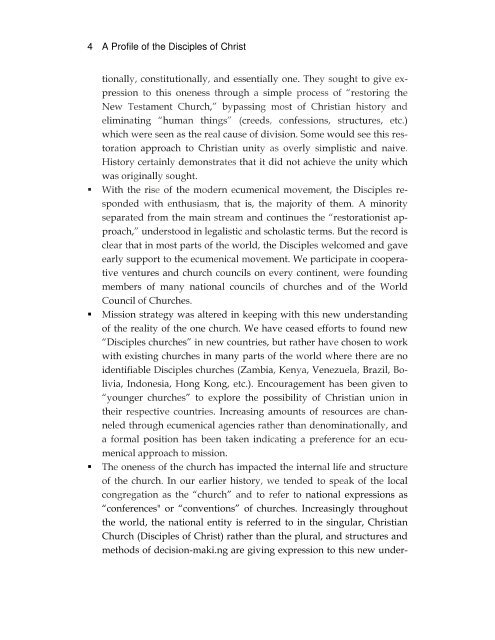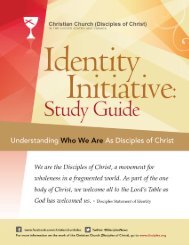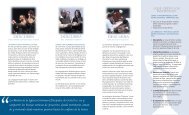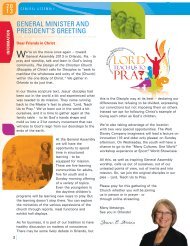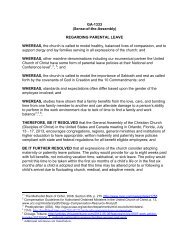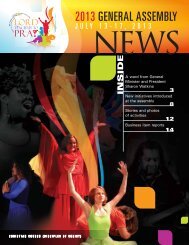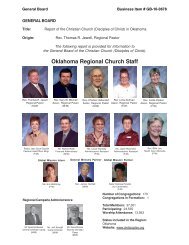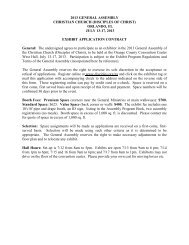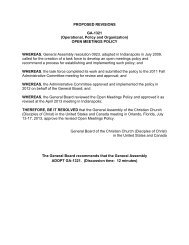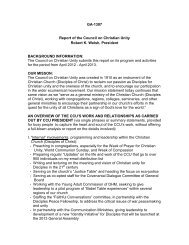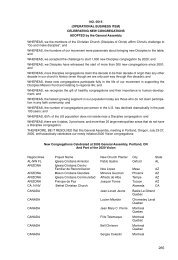"A Profile of the Disciples of Christ" by T.J. Liggett - Christian Church ...
"A Profile of the Disciples of Christ" by T.J. Liggett - Christian Church ...
"A Profile of the Disciples of Christ" by T.J. Liggett - Christian Church ...
Create successful ePaper yourself
Turn your PDF publications into a flip-book with our unique Google optimized e-Paper software.
4A <strong>Pr<strong>of</strong>ile</strong> <strong>of</strong> <strong>the</strong> <strong>Disciples</strong> <strong>of</strong> Christtionally, constitutionally, and essentially one. They sought to give expressionto this oneness through a simple process <strong>of</strong> “restoring <strong>the</strong>New Testament <strong>Church</strong>,” <strong>by</strong>passing most <strong>of</strong> <strong>Christian</strong> history andeliminating “human things” (creeds, confessions, structures, etc.)which were seen as <strong>the</strong> real cause <strong>of</strong> division. Some would see this restorationapproach to <strong>Christian</strong> unity as overly simplistic and naive.History certainly demonstrates that it did not achieve <strong>the</strong> unity whichwas originally sought. With <strong>the</strong> rise <strong>of</strong> <strong>the</strong> modern ecumenical movement, <strong>the</strong> <strong>Disciples</strong> respondedwith enthusiasm, that is, <strong>the</strong> majority <strong>of</strong> <strong>the</strong>m. A minorityseparated from <strong>the</strong> main stream and continues <strong>the</strong> “restorationist approach,”understood in legalistic and scholastic terms. But <strong>the</strong> record isclear that in most parts <strong>of</strong> <strong>the</strong> world, <strong>the</strong> <strong>Disciples</strong> welcomed and gaveearly support to <strong>the</strong> ecumenical movement. We participate in cooperativeventures and church councils on every continent, were foundingmembers <strong>of</strong> many national councils <strong>of</strong> churches and <strong>of</strong> <strong>the</strong> WorldCouncil <strong>of</strong> <strong>Church</strong>es. Mission strategy was altered in keeping with this new understanding<strong>of</strong> <strong>the</strong> reality <strong>of</strong> <strong>the</strong> one church. We have ceased efforts to found new“<strong>Disciples</strong> churches” in new countries, but ra<strong>the</strong>r have chosen to workwith existing churches in many parts <strong>of</strong> <strong>the</strong> world where <strong>the</strong>re are noidentifiable <strong>Disciples</strong> churches (Zambia, Kenya, Venezuela, Brazil, Bolivia,Indonesia, Hong Kong, etc.). Encouragement has been given to“younger churches” to explore <strong>the</strong> possibility <strong>of</strong> <strong>Christian</strong> union in<strong>the</strong>ir respective countries. Increasing amounts <strong>of</strong> resources are channeledthrough ecumenical agencies ra<strong>the</strong>r than denominationally, anda formal position has been taken indicating a preference for an ecumenicalapproach to mission. The oneness <strong>of</strong> <strong>the</strong> church has impacted <strong>the</strong> internal life and structure<strong>of</strong> <strong>the</strong> church. In our earlier history, we tended to speak <strong>of</strong> <strong>the</strong> localcongregation as <strong>the</strong> “church” and to refer to national expressions as“conferences" or “conventions” <strong>of</strong> churches. Increasingly throughout<strong>the</strong> world, <strong>the</strong> national entity is referred to in <strong>the</strong> singular, <strong>Christian</strong><strong>Church</strong> (<strong>Disciples</strong> <strong>of</strong> Christ) ra<strong>the</strong>r than <strong>the</strong> plural, and structures andmethods <strong>of</strong> decision-maki.ng are giving expression to this new under-


